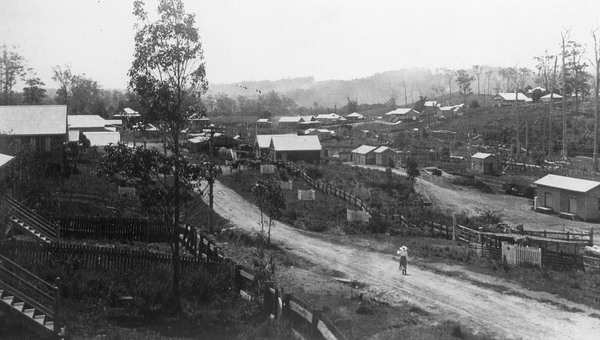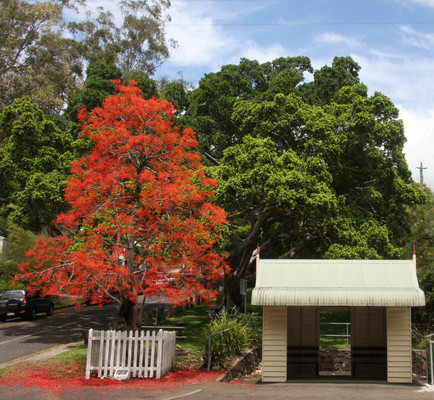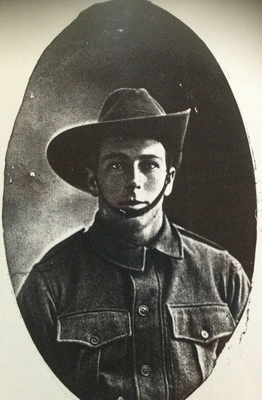By RON LANE
THROUGHOUT many countries of the world there stand monuments dedicated to those men and women who made the supreme sacrifice. Some large, some small, some magnificent, and in rare cases, some beautiful in their simplicity.
In the small country town of Eumundi stands what I believe to be twenty of the latter. For years I and many others have passed through the Eumundi thoroughfare known as Memorial Drive, aware that four trees that stand on the side walk are not just for shade. They stand in silent tribute to lives lost in far off lands during the First World War.
With this being the centenary of the landing at Gallipoli, and being the proud great nephew of a Gallipoli veteran and the son of a New Guinea veteran, I decided as a mark of respect to go in search of the history behind the trees.
My first discovery was that there were a further sixteen trees and all were planted for the same reason. From this small country community of Eumundi, eighty-seven men volunteered and twenty did not return. It was for me, the information that made the memorial trees something of great significance. So great was the impact of the trees on the community, that in 1977, when the main thoroughfare was known as Main Street they moved that the name be changed to Memorial Drive.
In a heritage register released by the Department of Environment and Heritage Protection, it states that the British Government prohibited the exhumation and return of bodies. With the cost and problems of overseas travel being way beyond the reach of the average family, it followed that memorials became essential – a place of remembrance, mourning and community respect.
Avenues of trees as memorials, and particularly those where each tree is attributed to a particular fallen serviceman were uncommon in Queensland. Most memorials erected during or after the First World War were of the monumental type.
The driving impetus for the planting of the memorial trees was provided by the Eumundi Women’s Patriotic Committee. Funds were raised by public subscription the total cost being approximately 100 pounds.
The trees were planted during and after the war. The original species were fig and of the twenty planted, five are extant and the other fifteen were replaced with other types including camphor laurels, lilly pillies and jacarandas. The first trees were planted between the railway gates and the CWA Hall, and the first two had to be replanted when the road was widened.
Each was surrounded by a two metre by two metre white paling fence and mounted on these were bronze plaques that contained the details of the fallen. Down through the years some of the trees and plaques have again been replaced, however some of the original plaques can be seen in the Eumundi Historical Museum.
Apart from Memorial Drive, trees have also been planted on the west side of Gridley Street which runs at right angles to Memorial Drive, within the boundary of Clem Park.
Of the twenty diggers remembered I found two to be of particular interest – the first being Herbert William Cooke and the second Walter Joseph Edward Gridley.
Herbert William Cooke, aged 21 rank Private, Service Number 425 enlisted on 23 September 1914, becoming a member of C Company 15 Battalion. After training in Egypt he landed at Gallipoli on 26 April. He was one of the many diggers sent to an area that was to become famous as ‘Quinns Post’.
There have been many words written to describe this post some of the most poignant being, “A day in hell doesn’t equal an hour in these trenches” another wrote “the ground itself, seemed to be wounded and bleeding.”
However in the words of Thomas Chataway 15 Battalion – a digger who was later to become renowned as the battalion historian – “We were the key position to the Anzac line and the post had to be held at all cost.”
It was into this hell on earth that 21-year-old old labourer Private Cooke from Eumundi was posted, and sadly on 30 April he was killed as a result of head wounds suffered while fighting in the trenches at Quinn’s. He was buried on the hillside to the right of their landing spot at Gaba Tepe – just two graves away from the famous John Simpson Kirkpatrick, the man with the donkey.
Walter Joseph Edward Gridley (known as Ted) age 24, Signaller, Service Number 1937 enlisted 23 August 1915.
Walter was originally a member of the Second Light Horse Regiment, but by 18 March 1918, he was a Signaller in the Sixth Army Field Artillery Brigade.
On 28 July 1918, while serving in France, Signaller Ted Gridley was severely wounded in action, suffering multiple gunshot wounds to the legs and compound fractures of the right wrist. He died that same day.
Apart from the major sacrifice of losing two sons, both families made outstanding contributions to the community. For the Gridley family apart from Ted, his brother Bob and five first cousins also served. Two of the cousins died one from wounds and the other from disease while a prisoner of war.
Both Teds grandfather Joe, and his father Walter, played major roles in the establishment and early days of Eumundi. The naming of Gridley Street in Eumundi is in tribute to this family.
For the Cooks, Herbert’s father George was the head teacher at the local state school. George was twice married, and as a result a family of seventeen children came into being. With the outbreak of war eight boys, sons and stepsons of George and his second wife Elizabeth Abraham, enlisted. Of the eight who enlisted, three – Herbert and two step brothers Cyril and Jabez Abraham – did not return.
In 1916 Queenslanders were at the forefront of sustaining public expression. They were the first citizens to establish Anzac Day as a day of remembrance, encouraging other states to join them in making Anzac Day a national commemoration.
The memorial trees have a strong and continuing association with the community. They also have a special association with the families of the fallen, some of whom still reside in the district.
So as we gather on Anzac Day to pay respect and remember those who have served, let us also pay a silent tribute to those people of Queensland whose patriotism and dedication has written a page in the annals of this nation’s history.
To the ladies of the Eumundi Women’s Patriotic Committee, who gave birth to this memorial, we salute you.










